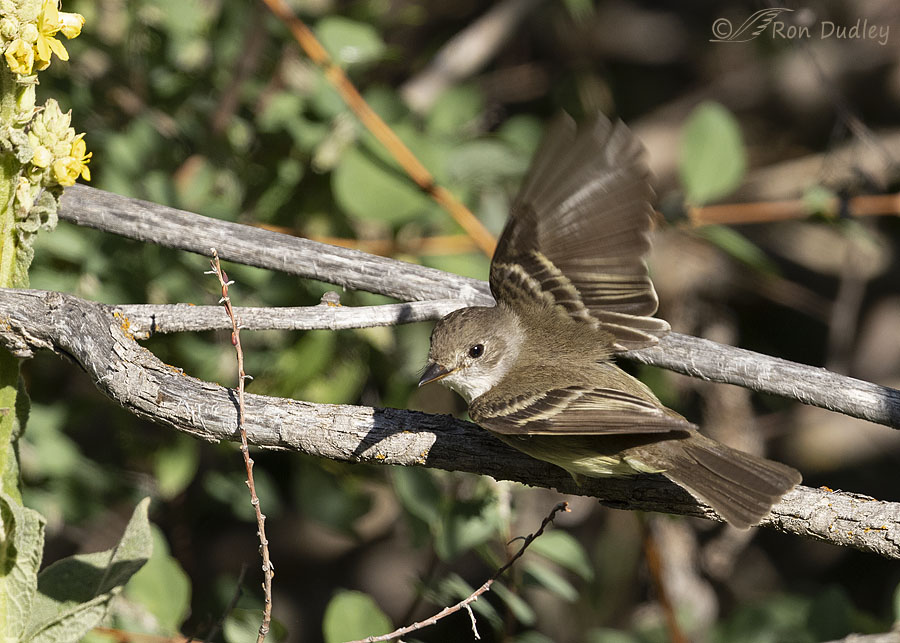A bird photographer’s intuition.

1/1250, f/7.1, ISO 800, Canon R5, Canon EF500mm f/4L IS II USM + 1.4 tc, not baited, set up or called in
Three days ago in the mountains I just knew this Willow Flycatcher would do something quick and interesting while I didn’t have enough shutter speed for the situation, and I was right. When ‘he’ took off to his left he only used his right wing during his first wing-stroke and kept his left wing mostly folded against his body, which resulted in two things – an unusual pose that caught my eye and his right wing showing a lot of motion blur. Even the rest of his body could have been a little sharper.
But in this situation I can live with the motion blur because it implies the extremely fast motion you’d expect and draws attention to the unusual position of his right wing relative to his left wing. A head turn that was just about perfect, light in his eye and the flowering mullein at the left frame edge sealed the deal.
To be perfectly honest, I’m not positive this is a Willow Flycatcher. The hint of yellow on his flank makes me wonder if it’s a Dusky Flycatcher instead. Because of their distinctive call I know most flycatchers in this area are Willow Flycatchers but I never heard a peep out of this guy.
As most bird lovers know, getting positive visual ID’s on Empidonax flycatchers is one of the most intimidating challenges for even the most highly skilled birders in North America. And I’m a rank amateur.
Ron


If I had time, I’d probably write my usual novella here but things are … whatever … so I will just say I love this image, adore flycatchers of any type so matters not his flavor. As always, thanks for the day brightener!
whatever … so I will just say I love this image, adore flycatchers of any type so matters not his flavor. As always, thanks for the day brightener! 
That motion blur doesn’t distract (or detract) at all for me. The small birds make greased lightening look slow don’t they?
Glad to see the knowledgeable Dan chime in and support your ID.
“The small birds make greased lightening look slow don’t they?”
They sure do, EC. This bird was too fast to react to. I just got lucky.
Without voice, these flycatchers are difficult to distinguish from each other, or impossible in some cases. But Willow Flycatcher would be my guess as well. Willow Flycatcher has a less distinct eyering than Dusky (not always easy to tell) and the entire mandible is paler on Willlow. A Dusky Flycatcher has a mandible that is lighter at the base but darker at the tip, which is another feature often impossible to see. In your photo, the entire length of the mandible appears lighter than the maxilla but it’s subtle. Unless I get voice, I usually just conclude that I’m seeing an Empionax flycatcher and leave it at that.
“Unless I get voice, I usually just conclude that I’m seeing an Empionax flycatcher and leave it at that.”
That’s probably good advice for nearly all of us, Dan.
I give you A’s for this post:
Just capturing a photo of this Flycatcher, or any Flycatcher. I’ve heard them, and had birders I was with ID them from song, but never even seen one.
Hazarding an ID to species. Unless an expert chimes in or someone wishes to wade through the tables in the linked article, I’ll go with your judgment.
The yellow Mullein and touch of yellow on his flank add subtle matching highlights.
One of my references states “it is suspected that even the birds depend heavily on song to sort out who is who in order to avoid hybridizing.”
Lyle, several friends who are pretty darn close to “experts” say this is most likely a Willow Flycatcher so I’m going to stick with that.
And I love your quote at the end of your comment.
Really appreciate the photo specs along with the photo. It’s helping me with my photography.
Good to know, Michael. Thanks.
We have olive flycatchers where I am in New Mexico. I love how they fly so fast.
They take off fast too, Arwen. I was lucky to get this shot.
Kind of like the blur. Nice shot Ron. No opinion from me one way or another regarding Flycatchers. If I took the shot I would have sent it off to one of my local expert friends for ID. Flycatchers are one of those groups that always puzzle me.
Thanks, Everrett. They puzzle me too.
Love the pose, Mr. Dudley. It’s always interesting when animals do things that seem asymetrical. I wonder what the legs are doing. Thanks for the great photographs.
Thank you, Mark. I suspect his legs are pushing off against the branch.
Wonderful catcher! Really caught the wing action and blur doesn’t detract at all in my opinion. Flycatchers are busy right now here – not sure of type but they ARE tiny, fast, and have a crest.
Really caught the wing action and blur doesn’t detract at all in my opinion. Flycatchers are busy right now here – not sure of type but they ARE tiny, fast, and have a crest. 
Thankfully, most of the Miller’s have finally departed tho a few more in the house than there were……
Thanks, Judy. I wouldn’t miss having most of the millers gone either.